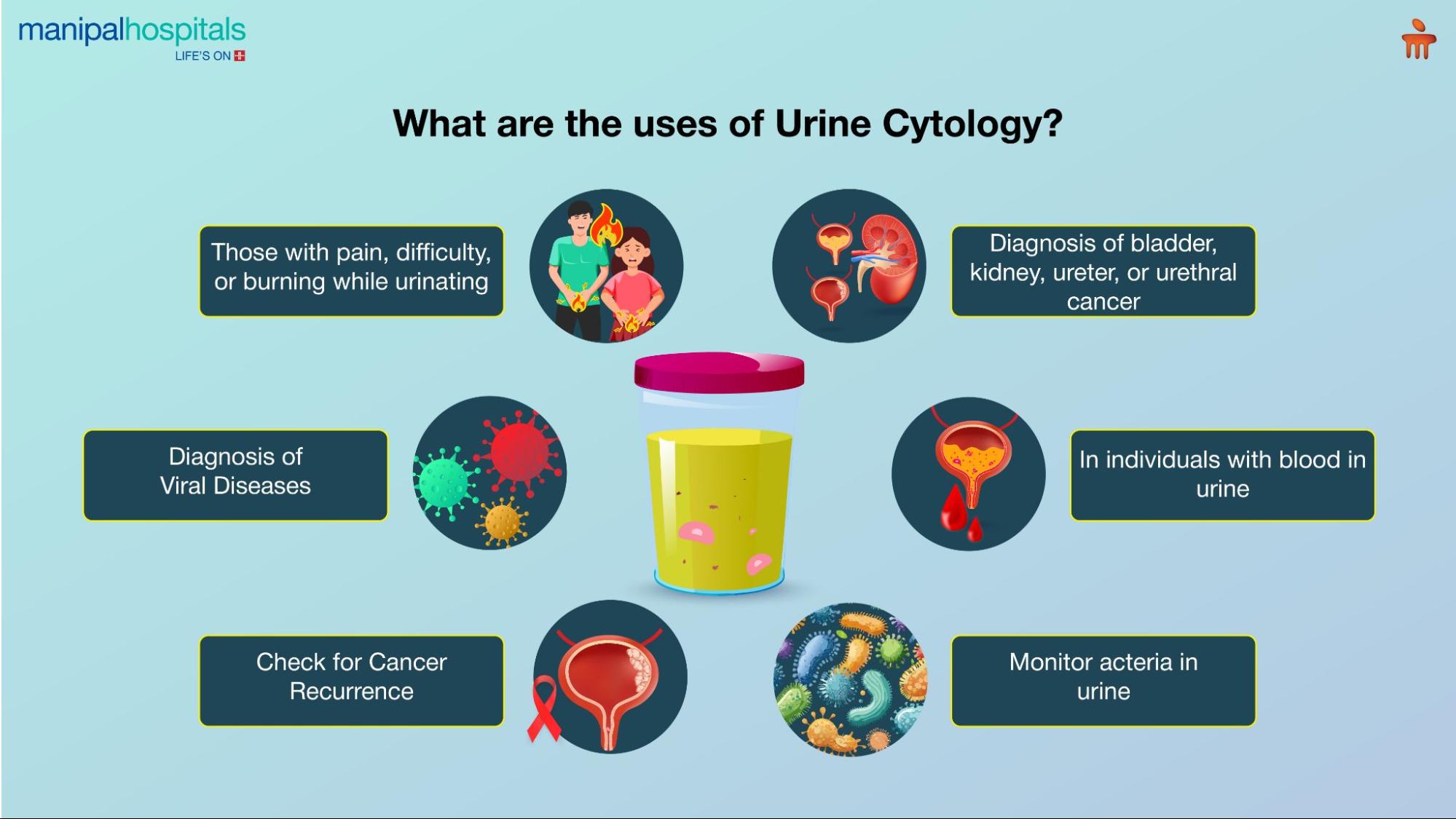Urine Cytology is useful for diagnosing invasive high-grade tumours and carcinoma in situ affecting the urinary tract. Unlike urine culture tests, the test is performed when there is a clinical indication or high index of suspicion for urothelial malignancy. The high-grade tumours are diagnosed with a sensitivity of 95%, while the low-grade tumours are detected with a sensitivity of 10 to 50%.
Read below to get a comprehensive view of the Urine Cytology test.
Synopsis
What Is Urine Cytology?
It is a test that examines cells in urine under a microscope to diagnose cancer cells, cancer in the urinary tract, and specific viral diseases. A cytopathologist examines the urine sample under a microscope to diagnose certain cell characteristics and abnormalities. It is often recommended for a history of blood in the urine.
Why Is It Done?

Doctors recommend the test to diagnose bladder, kidney, ureter, or urethral cancer. It is ordered if you have the following symptoms:
-
Blood in urine
-
Pain while urinating
-
Difficulty urinating
-
Burning sensation while urinating
Apart from cancer, it helps in the diagnosis of cytomegalovirus, herpes virus, and other viral diseases. Urine Cytology tests also help check for cancer recurrence in individuals treated for bladder cancer and monitor bacteria in urine in individuals with persistent urinary tract infections.
How Is Urine Cytology Performed?
A urine sample is collected for analysis. The sample cannot be from first-morning urine, as the urine remains in the bladder overnight and may be too degraded to analyse. The sample is collected in one of the two ways:
The clean catch: This helps prevent the contamination of urine samples with germs that are present near the vulva or skin on the penis. You will be provided with a special kit to collect urine, which includes a cleaning solution and sanitary wipes to clean your genital area. Collect the sample by following these measures:
-
Wash your hands with soap and clean your urethral opening
-
Urinate in the toilet for a few seconds and stop
-
Restart the urine to collect the sample in a sterile cup provided
-
Close the container without touching the inside contents
-
Label the container with your information
-
Return the container with a sample to your healthcare provider
Catheter: A urine sample may also be collected through a small tube that is inserted into the urethra and moved into the bladder. This may increase the risk of urinary tract infection.
Once the urine sample is submitted to the laboratory, the technician examines the sample under a microscope for abnormal cells. A centrifuge is used to separate specific cells to be examined under a microscope. The separated cells are placed on a microscope slide and stained with special coloured dyes for better visualisation. The urine test report will be sent to the doctor to determine the results.
What Are the Possible Urine Test Report Results and What Do They Mean?
Several terms may be used in the Urine Cytology test report. However, most often it means whether the urinary sample was positive or negative for precancerous or cancerous cells. Some of the terms include:
-
Unsatisfactory specimen: If enough cells are not present in the urine sample, the diagnosis becomes difficult. You may have to repeat the test.
-
Negative for high-grade urothelial carcinoma: This means no cancer or abnormal cells were found in the urine sample.
-
Atypical urothelial cells: The pathologist found abnormal cells in your urine sample, but they cannot be characterised as cancerous cells.
-
Suspicion for high-grade urothelial carcinoma: It indicates the pathologist found abnormal cells in a urine sample that may be cancerous
-
Positive for high-grade urothelial carcinoma: This confirms that cancerous cells were found in the urine.
Abnormal cells in urine need not always be a sign of cancer; it could also mean inflammation within the urinary tract or the outcome of radiation therapy near the bladder.
Are Urine Cytology and Urine Culture Tests the Same?
Although urine cytology and urine culture tests are diagnostic tools that examine the urine, they are characteristically different.
A Urine Cytology test involves observing the urine sample under a microscope to look specifically for cancer cells, whereas a urinary culture test is a screening procedure to diagnose urinary conditions such as urinary tract infections, kidney diseases, and diabetes. A urine culture test also helps characterise the appearance, concentration of urine, and presence of leukocytes in urine.
Is Urine Cytology a Confirmatory Test for Cancer?
Although the test can detect abnormalities, it cannot confirm the cancer by itself. If the test fails to detect cancer cells, it does not mean the individual is cancer-free. They may need to undergo additional tests like imaging studies and cytoscopy for an accurate diagnosis, or may have to repeat the test at a later date.
Conclusion
Urine Cytology tests can help in the detection of urinary system cancers. However, the test is just not enough; you may have to undergo additional tests for a urinary cancer diagnosis. Consult our expert Urologists at Manipal Hospitals, Mukundapur, for early diagnosis of urinary cancer and comprehensive treatment.
FAQ's
Key abnormalities diagnosed are:
-
Cancerous cells: These cells appear larger and more irregular than normal cells
-
Inflammation cells: It is present when there is infection or inflammation
-
Benign changes: Stress or injury to cells causes some changes in urinary cells
It is used to detect bladder cancer, monitor the progression of disease and cancer treatment, investigate the cause of blood in urine, identify the cause of urinary tract infections, and diagnose kidney or urethral cancer.
-
Maintain adequate hydration before the test to ensure proper concentration of cells in urine
-
Inform your doctor about the medications you are taking
-
If possible, try to avoid undergoing the test during menstruation
A positive test means abnormal cells were found in urine, but it does not necessarily indicate cancer. Further tests may be necessary to determine the cause of abnormal cells.
It is a non-invasive and painless test that requires collecting a urine sample.





















 6 Min Read
6 Min Read













